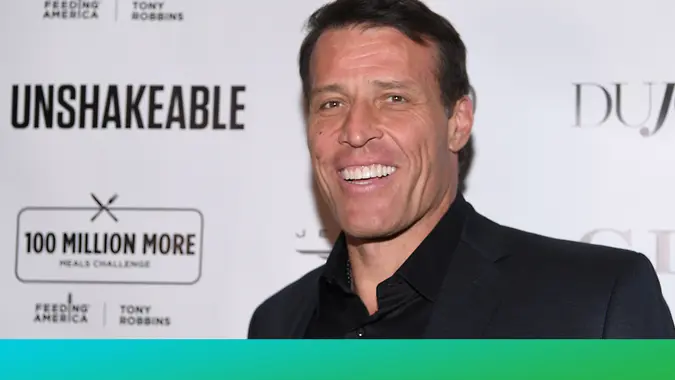How Much Money Do I Need To Start Investing?

Commitment to Our Readers
GOBankingRates' editorial team is committed to bringing you unbiased reviews and information. We use data-driven methodologies to evaluate financial products and services - our reviews and ratings are not influenced by advertisers. You can read more about our editorial guidelines and our products and services review methodology.

20 Years
Helping You Live Richer

Reviewed
by Experts

Trusted by
Millions of Readers
Investing has become much more retail-friendly over the past few decades, with plummeting commissions, online access to accounts and lowered investment minimums. If you’re just starting out and have little money to invest, this is great news. If you start investing early enough, even small amounts, given the chance to compound over a long period of time, can result in significant savings by the time you retire.
Still, many investments do have at least some minimum investment amount — and the more you can sock away, the better. Here’s a look at some common investment minimums, along with some financial suggestions from well-known experts.
Index Funds
Billionaire investors like Warren Buffett have championed the use of index funds for most investors. The CEO of Berkshire Hathaway has gone so far as to direct that 90% of his estate be placed in low-cost index funds to benefit his family after he passes. Billionaire Mark Cuban is another proponent of using low-cost mutual funds for most investors. Most exchange-traded index funds have a nominal investment minimum, such as $1, while more traditional mutual funds might require $3,000 or more to get started.
Individual Stocks
Individual stocks are easier to buy than ever, especially for no commission. However, some firms still require you to purchase whole shares. In this case, you’ll need at least as much as the cost of a single share to start investing. In some cases, this can be just a few dollars, but in the case of a company like Berkshire Hathaway, you’ll need about $482,000. Just remember that it’s hard to get a diversified portfolio by buying individual shares of stocks with limited funds.
Robo-Advisors
Robo-advisors are relatively new to the investment world, but they have made a splash and now manage billions of investor assets. For just a few hundred dollars — or even zero at some firms — you can get access to a portfolio of ETFs matched to your investment objectives and risk tolerance.
Real Estate
There are different lower-cost ways you can buy real estate, such as through real estate investment trusts or groups. You can buy REITs on the open market, for example, with no minimum — if you have a broker that sells fractional shares — and you can join a group for perhaps nothing as well. But for a direct purchase of real estate, you’ll need at least a down payment, which typically requires tens of thousands of dollars — if not more.
Bonds
Bonds are typically issued in $1,000 increments, so you’ll usually need at least that much to buy one. Some firms have higher minimums, such as $5,000 to $10,000. Treasury savings bonds, however, can be bought with as little as $25.
CDs and High-Yield Savings Accounts
Certificates of deposit and high-yield savings accounts are the bread and butter of conservative investors. They typically pay much more in interest than standard savings accounts at traditional banks, yet they carry the same FDIC insurance. Currently, investors can get yields in the high 3% to 4%-plus range on short-term CDs and savings accounts. Minimums are generally zero or nominal for high-yield savings accounts, but CDs may require $1,000 or more to buy.
Investment Apps
Investment apps are becoming more and more popular, offering everything from budgeting services to full-blown investment options. Most have very small minimums, often as low as $0. However, if you’re starting out with a small amount, be wary of fees. While some apps have no fees, others may charge a seemingly small $3 or $5 per month — but if you only have a few hundred dollars invested, that becomes a significant percentage of your entire account.
IRA
An IRA isn’t an investment, but rather an account that offers various tax advantages. One of the most important of these is the tax-deferred growth of your investments — or even tax-free, in the case of a Roth IRA. Maximizing your contributions to an IRA is a good way to boost your retirement nest egg, so try to contribute as much of the 2023 maximum of $6,500 as you can. Note that if you’re 50 or older, you can kick in an additional $1,000 per year.
401(k) Plan
Like IRAs, company-sponsored 401(k) retirement plans have no investment minimum. However, if you want to maximize the value of your account by the time you retire, it’s best to contribute as much as you can. This is particularly true if you can earn a company match on your contributions. For 2023, the maximum voluntary 401(k) contribution is $22,500 — increasing to $30,000 for those 50 and older.
The Power of Compound Interest
Don’t be deterred if you think you don’t have much money to put into your investments. If you start early enough, even small sums can reap big rewards over time. For example, imagine that you’re 20 years old now, socking away $200 per month into a stock market index fund that garners you an 8% average annual return. If you’re using a tax-deferred account like an IRA, by the time you retire at age 65, you’ll have more than $1 million tucked away.
More From GOBankingRates
 Written by
Written by  Edited by
Edited by 

























